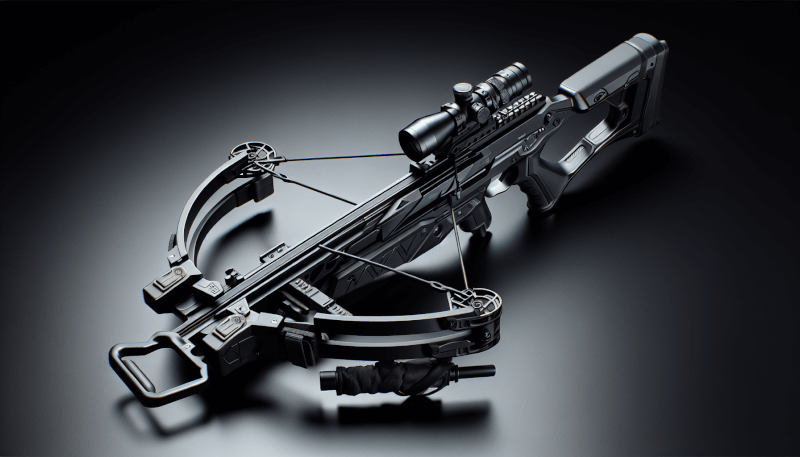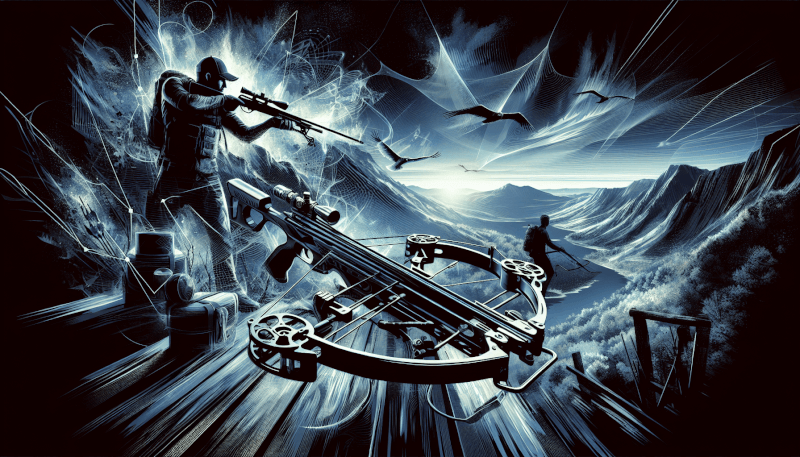Imagine yourself in the great outdoors, surrounded by nature’s beauty. As you embark on your thrilling adventures, you need a reliable companion by your side. Introducing the Sports Outdoor Gear Crossbow, a remarkable piece of equipment that will elevate your outdoor experiences to new heights. This crossbow is meticulously designed with precision and power in mind, ensuring that every shot hits its mark with remarkable accuracy. Whether you’re an experienced hunter, an adrenaline-seeking marksman, or simply someone who enjoys target practice, this crossbow is the perfect addition to your arsenal. With superior craftsmanship and unparalleled performance, the Sports Outdoor Gear Crossbow is ready to take you on unforgettable journeys.
Overview of Crossbows
What is a crossbow?
A crossbow is a type of projectile weapon that consists of a bow mounted on a stock or frame, with a mechanism to shoot bolts or arrows. It combines the principles of a bow and a firearm, allowing for increased accuracy and power compared to traditional bows. Crossbows have been used for centuries in hunting, warfare, and recreational shooting.
History of crossbows
Crossbows have a rich history that dates back thousands of years. They were first invented in ancient China around the 5th century BC and quickly spread to other parts of Asia, Europe, and the Middle East. In Europe, crossbows became a popular weapon during the Middle Ages, replacing the longbow as the primary ranged weapon of choice for knights and foot soldiers. Over time, crossbow technology advanced, leading to the development of more powerful and accurate versions.
Types of crossbows
There are several different types of crossbows available on the market today, each with its own unique features and advantages. The most common types include recurve crossbows, compound crossbows, and pistol crossbows. Recurve crossbows have limbs that curve away from the shooter, while compound crossbows use a system of pulleys and cables to generate more power. Pistol crossbows are smaller and handheld, making them ideal for target shooting and small game hunting.
Advantages of Crossbows
Accuracy
One of the key advantages of crossbows is their exceptional accuracy. Compared to traditional bows, crossbows are easier to aim and maintain a consistent level of accuracy over longer distances. This makes them an excellent choice for both hunting and target shooting.
Power
Crossbows are known for their sheer power. With their mechanical advantage and the ability to use heavier bolts or arrows, crossbows can deliver tremendous force on impact. This makes them highly effective for hunting larger game animals, such as deer or elk, where a powerful shot is necessary for a clean and ethical kill.
Ease of use
Another advantage of crossbows is their ease of use, particularly for beginners or individuals who may have physical limitations. Unlike traditional bows that require a significant amount of upper body strength, crossbows can be cocked and held at full draw using a mechanical device. This allows for longer periods of aiming and increased accuracy without fatigue.
Stealthiness
Crossbows offer a level of stealthiness that firearms cannot match. The relatively quiet shot of a crossbow allows hunters to get closer to their prey without alarming them. This is especially useful in situations where noise could spook animals, such as when hunting in dense forests or during periods of increased alertness in wildlife.

Key Components of a Crossbow
Stock
The stock of a crossbow is the main body or frame that provides stability and support. It is usually made of lightweight but durable materials such as wood, aluminum, or carbon fiber. The stock houses various components, including the limbs, trigger mechanism, and the scope.
Limbs
The limbs of a crossbow are the flexible parts that store and release energy when the bowstring is drawn back. They can be made from fiberglass, carbon fiber, or other composite materials. The design and construction of the limbs play a crucial role in determining the power and performance of the crossbow.
Bowstring
The bowstring is an essential component of a crossbow as it transfers energy from the limbs to the bolt or arrow. It is typically made from strong synthetic materials such as Dacron or Fast Flight. The bowstring needs to be regularly checked for signs of fraying or damage and replaced if necessary to ensure optimal performance and safety.
Trigger mechanism
The trigger mechanism is responsible for releasing the bowstring and allowing the crossbow to fire. It consists of a trigger, sear, and latch mechanism that ensures the string remains engaged until the trigger is pulled. A high-quality trigger mechanism is crucial for consistent and reliable shot accuracy.
Scope
Many crossbows come equipped with scopes or optical sights to aid in aiming and target acquisition. A scope provides magnification and crosshairs, allowing the shooter to accurately align the shot. Some scopes even have built-in range-finding features or illumination for low-light conditions, further enhancing the shooter’s accuracy.
Choosing the Right Crossbow
Purpose of use
When choosing a crossbow, it is essential to consider the intended purpose of use. Are you planning to use it for hunting, target shooting, or both? The intended use will play a significant role in determining the necessary specifications and features required for your crossbow.
Draw weight
Draw weight refers to the force required to cock the crossbow and draw back the bowstring. It is an important factor to consider as it affects both the power and ease of use of the crossbow. Higher draw weights generally result in more power but may be more challenging to handle, especially for beginners or individuals with limited strength.
Speed
The speed at which a crossbow can shoot bolts or arrows is measured in feet per second (FPS). The higher the FPS, the faster the projectile will travel and the flatter the trajectory. Faster crossbows are advantageous for hunting as they offer a better chance of a clean and humane kill, especially when targeting animals that may be prone to move quickly.
Size and weight
The size and weight of a crossbow are important considerations, particularly if you plan to carry it for extended periods or through challenging terrain. Lighter and more compact crossbows are generally easier to maneuver but may sacrifice some power. Consider your physical capabilities and hunting conditions when deciding on the appropriate size and weight of the crossbow.
Budget
Like any other purchase, it is essential to establish a budget when buying a crossbow. Crossbows are available at various price points, and while higher-end models may offer superior performance and features, they may not be within everyone’s budget. It is possible to find a quality crossbow that meets your needs without breaking the bank, but it is important to be realistic about your budget constraints.

Crossbow Accessories
Bolts/Arrows
Bolts or arrows are the ammunition used with crossbows. It is crucial to select bolts or arrows that are compatible with your specific crossbow model and designed for the intended use. Different types of bolts and arrows are available, including those for target shooting or hunting, with varying points, fletchings, and weights.
Broadheads
Broadheads are the tips or heads of arrows specifically designed for hunting with a crossbow. They have sharp blades that cause a wide wound channel upon impact, increasing the chances of a quick and ethical kill. There are different types of broadheads, including fixed-blade and mechanical broadheads, each with its own advantages and considerations.
Cocking mechanisms
Cocking a crossbow can be physically demanding, especially with higher draw weight models. Cocking mechanisms, such as rope cocking devices or crank cocking devices, can make the process easier and reduce the strain on the shooter. These accessories are particularly useful for individuals with limited upper body strength or who want to ensure consistent cocking each time.
Quivers
Quivers are accessories that hold and store bolts or arrows securely on the crossbow. They come in various designs, including detachable quivers that can be mounted to the stock or integrated quivers that are built directly into the crossbow. Quivers not only provide easy access to additional ammunition but also help in keeping the bolts or arrows organized and protected.
Optics
Optics, such as scopes or red dot sights, can greatly enhance the accuracy and aiming capabilities of a crossbow. Scopes provide magnification and crosshairs, allowing for precise shot placement. Red dot sights offer a more open field of view with a projected red dot or reticle for targeting. Consider the shooting conditions and your personal preferences when choosing the appropriate optics for your crossbow.
Safety Considerations
Proper handling and storage
Safety should always be a top priority when using and storing a crossbow. It is vital to familiarize yourself with the manufacturer’s guidelines and instructions for safe operation. Always handle the crossbow with care, keeping your fingers away from the string and trigger until ready to shoot. When not in use, store the crossbow in a secure and locked location, away from children and unauthorized individuals.
Use of safety gear
Wearing appropriate safety gear is essential when using a crossbow. Eye protection, such as safety glasses or goggles, should be worn to protect against any possible projectile fragments or debris. Additionally, finger guards or gloves can prevent accidental finger injuries while cocking or shooting the crossbow.
Legal regulations
Before using a crossbow, it is important to familiarize yourself with the legal regulations pertaining to its use in your area. Different jurisdictions may have specific rules and restrictions regarding crossbow hunting, shooting ranges, or transportation. Adhering to these regulations ensures not only your own safety but also helps support responsible and sustainable use of crossbows.
Maintenance and Care
Cleaning
Regular cleaning is necessary to keep the crossbow in optimal condition. Remove any dirt, debris, or moisture from the stock, limbs, and trigger mechanism using a soft cloth or brush. Pay close attention to areas where dirt or grime may accumulate, such as the trigger assembly or arrow rail. Avoid using harsh chemicals or solvents that could damage the components.
String maintenance
The bowstring is a critical component of the crossbow, and proper maintenance is essential to prolong its lifespan and ensure reliability. Regularly inspect the string for fraying or signs of wear and replace it if necessary. Additionally, applying a specialized string wax or lubricant can help reduce friction and extend the string’s durability.
Lubrication
Applying lubrication to moving parts, such as the trigger mechanism or latch assembly, can help ensure smooth and consistent performance. Use a high-quality lubricant designed for crossbows and apply it sparingly to avoid excessive build-up. Be sure to follow the manufacturer’s instructions and recommendations for lubrication intervals.
Checking for wear and tear
Regularly inspect the crossbow for any signs of wear and tear, such as loose bolts, cracks in the stock, or fraying cables. Address any issues immediately to prevent further damage or potential safety hazards. Consult the manufacturer or a professional if you are unsure of how to properly repair or replace any components.
Storage
When the crossbow is not in use, proper storage is important to protect it from damage and ensure its longevity. Store the crossbow in a dry and temperature-controlled environment, avoiding extreme heat or cold. Consider disassembling the crossbow if storing for an extended period to reduce tension on the limbs and string. Use a suitable case or cover to protect the crossbow from dust, moisture, and accidental damage.
Crossbow Hunting Tips
Choosing the right game
When hunting with a crossbow, it is crucial to choose the right game that is appropriate for the power and accuracy of your specific crossbow. Different game animals have different size and weight requirements for ethical hunting. Take into consideration local hunting regulations and guidelines to ensure compliance.
Hunting techniques
Crossbow hunting requires patience, stealth, and knowledge of animal behavior. Learn about the habits and movement patterns of your target game species to increase your chances of success. Utilize tree stands or ground blinds for concealment and proper shot angles. Consider practicing with your crossbow in hunting scenarios to improve your shooting skills and accuracy in real-life situations.
Shot placement
Shot placement is critical when hunting with a crossbow to ensure a quick and humane kill. The vital organs of game animals, such as the heart and lungs, are the primary targets. Aim for broadside shots to maximize the chance of hitting vital organs effectively. Always use the appropriate broadheads for hunting to increase the chances of a clean kill.
Tracking wounded animals
Even with a well-placed shot, tracking wounded game animals may be necessary. Use visual cues, such as blood trails or disturbed foliage, to follow the path of the wounded animal. Remember to exercise patience and caution while tracking to prevent unnecessary suffering and ensure a successful recovery.
Ethical considerations
Ethical hunting practices are crucial when using a crossbow. Always follow local hunting regulations and guidelines, including hunting seasons, bag limits, and legal shooting hours. Respect the natural environment and wildlife, only taking shots within your skill level and the capabilities of your crossbow. Consider donating harvested game meat to minimize waste and support conservation efforts.
Tips for Crossbow Target Shooting
Choosing a suitable target
Selecting the right target is essential for safe and effective crossbow target shooting. Choose a target specifically designed for crossbow use, as regular archery targets may not withstand the higher energy and impact of crossbow bolts or arrows. Foam block targets or bag targets are popular options that offer both durability and easy arrow removal.
Range setup
Setting up a safe and proper shooting range is important for crossbow target shooting. Ensure there is a clear and unobstructed shooting lane with a designated target area. Place backstops or barriers behind the target to prevent stray bolts from traveling beyond the designated range. Consider using ground stakes or target stands to securely position the target at an appropriate height and angle.
Aiming and shooting techniques
Aiming with a crossbow is similar to using a rifle or firearm. Use the scope or sights to align the target and ensure proper sight picture. Practice proper shooting form, including a stable stance, a firm grip on the stock, and a relaxed but consistent trigger pull. Remember to maintain focus on the target throughout the shot process.
Scoring and improving accuracy
Scoring your shots can help track your progress and improve accuracy over time. Utilize target scoring rings or a system to assign scores to each shot based on their proximity to the bullseye. Analyze your shots and identify any consistent patterns or errors to make necessary adjustments to your shooting technique or equipment.
Competitions and clubs
For those interested in taking crossbow target shooting to the next level, consider participating in competitions or joining local clubs or organizations dedicated to the sport. Competitions provide an opportunity to test skills against others and showcase proficiency in various shooting disciplines. Clubs offer a community of fellow enthusiasts who can share knowledge, tips, and camaraderie.
Conclusion
In conclusion, crossbows are versatile and powerful sports outdoor gear that offer a range of advantages over traditional bows and firearms. With their accuracy, power, ease of use, and stealthiness, crossbows are popular among hunters and target shooters alike. By understanding key components, choosing the right crossbow and accessories, prioritizing safety, and maintaining and caring for the equipment properly, individuals can enjoy the full potential of crossbows as a rewarding and exciting outdoor pursuit. Remember to always adhere to legal regulations, practice ethical hunting, and continue improving your shooting skills. Embrace the crossbow as a valuable tool for outdoor sports and recreation.


